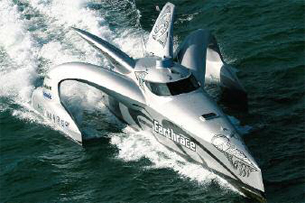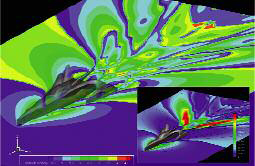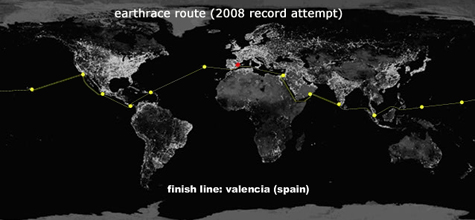Latest News
September 1, 2008
By Barb Schmitz
 The Earthrace looks more like a space cruiser from the imagination of Steven Spielberg than a circumnavigating powerboat. The vessel beat the previous power circumnavigation world speedrecord by two weeks aided by its wave-piercing design and fueled by biodiesel. |
This boat doesn’t resemble most other boats you’d commonly find on the water. Two arcing outer hulls, shaped like frog’s legs ready to leap, extend from the main cabin, which sports a pair of stubby wings aft that actually vent hot air from the engine compartment. It looks like a vessel more suited for spaceflight than sea journeys, and despite its appearance, it was designed to embark on the longest ocean voyage possible, circling the globe.
Its unique appearance isn’t without purpose. To enable the boat to travel at very high speeds and to endure the worst possible weather conditions, the vessel was designed to pierce a wave instead of passing over it. And aesthetics are not the only things that separate this boat from the pack. While the boat runs on twin diesels, its fuel comes from plant fiber and animal fat. When the engines burn, the air smells like french fries, not petroleum.
This boat is Earthrace, the manifestation of an idea spawned by a former oil industry engineer, 43-year-old New Zealander Pete Bethune, who decided it wasn’t enough to just talk about doing something for the environment. The goal of Earthrace was to set a world record for a powerboat to circumnavigate the globe, running on 100 percent renewable biodiesel fuel, and with a net zero carbon footprint.
 The entire boat is intended to pierce waves, minimizing pitching motions and preventing pounding of the shell. With fine-tuning derived from simulations like this one, engineers made sure the boat could withstand seven meters (24 ft) of water above themain cabin’s windscreen. |
A large number of engineers and scientists from across the globe have invested large amounts of time, expertise, and resources in the design and building of Earthrace.
Wave-Piercing Design
The team at Craig Loomes Design Group (CLD) of New Zealand designed Earthrace. Wave-piercing technology was originally formulated for passenger ferry applications, and more recently it has been applied to military craft. Wave-piercers lead with a sharp bow and minimal reserve buoyancy in the forward portions of the hull to reduce vertical motion.
 FLOW-3D computational fluid dynamics software was used to simulate the speed of the boat on top and through the water in varying sea conditions to refine the vessel’s design. Here, pressure indices areindicated in flat water. |
“Prior to the development of Earthrace, we had already spent considerable time developing the wave-piercer, trimaran concept,” says André Moltschaniwskyj, director at CLD. “We had also constructed a 6.6-meter-long powered model that could carry a crew of three.”
The basic concepts for Earthrace, which totals 24 meters and actually runs with a crew of four, started as pencil sketches, says Moltschaniwskyj. The designers then created 2D CAD drawings of the basic side profile and plan views in Ashlar Graphite software from Ashlar-Vellum. After the design team approved the 2D drawings, a 3D model of the boat’s hull and deck geometry were created using Formation Design Systems’ Maxsurf software, a specialty marine design program based on trimmed NURB surfaces. Maxsurf was also used for performance prediction and hydrostatics work.
According to Moltschaniwskyj, the final 3D modeling and rendering was completed with Rhino freeform 3D modeling and Flamingo software, which are developed and sold by McNeel North America. Flamingo, optional plug-in software for Rhino, provides raytrace and radiosity rendering.
Building a Better Boat
“Structural engineering was carried out using in-house developed software and spreadsheets,” says Moltschaniwskyj, “although some specific finite-element work was done on the cross-arm structure that attaches the sponsons to the main hull using MSC.Software’s Nastran FEA software. The complexity of the combined bending, shear, and torsion problems on the freeform spar made conventional analysis very difficult.”
Germanischer Lloyd in Hamburg,Germany, the classification authority involved in the structural plan approval process, also did a significant amount of CFD work on vessel motions to create meaningful load prediction algorithms. “This work yielded the first spectacular images of the design’s wave piercing,” says Moltschaniwskyj, “and allowed us to design the structures using water pressure and load cases far more applicable to Earthrace than the structural guidelines normally used for conventional hull forms.”
As part of an ongoing research and development program into this relatively novel hull type, the CLD team focused on optimizing fuel efficiency to minimize refueling stops and also on ride comfort, allowing the crew to maintain high average speeds in both flat and rough seas. Common to all of the power trimaran design work, the entire boat is intended to pierce waves, minimizing pitching motions and preventing slamming or pounding of the bottom shell, resulting in a dramatically smoother ride than traditional deep-V designs, minimizing stress on the vessel as well as the crew. The design was the key element in what turned out to be a record circumnavigation attempt.
The piercing action is controlled by pumping up to 2.5 tons of water into a special ballast tank in the bow. The more water in the bow and the faster the boat is traveling, the more it pierces.
Tests conducted on a 20-meter vessel fitted with pitch/heave/yaw accelerometers indicated significant improvements in ride quality in comparison to conventional monohull designs, representing a major step forward in yacht design technology. “This boat was instrumented with accelerometers and was used to evaluate a number of parameters, including ride qualities, handling and maneuverability, hull resistance and powering, wake interaction between main hull and sponsons,” says Moltschaniwskyj. “Much of this knowledge was thus applied to the design of Earthrace.”
 Sail west, young man: The route traveled by Earthrace began and ended in Valencia, Spain, andcontinued west for a total 61 days. |
Plotting a Faster Course
Another company involved in the simulation of the Earthrace was XC Engineering, an engineering consultancy that specializes in CFD and thermal-analysis technologies. The company, based in Cantu, Italy, used FLOW-3D computational fluid dynamics (CFD) software from Flow Science, Inc. of Santa Fe to refine the design of Earthrace.
The engineering team at XC Engineering used Tecplot 360 software to demonstrate a dynamic simulation of Earthrace while piercing a 4-meter wave. Stefano Mascetti, an aerospace engineer with XC Engineering, explains the importance of using CFD simulations to design the boat: “Fluid dynamic simulation is helpful to understand the response of the boat facing the waves and the pressure forces acting over the hull,” he says. “A good computation of pressure forces is fundamental in order to dimension the structure of the boat correctly and to make it as light as possible.”
The data for the plot was generated using FLOW-3D. Mascetti explains the many reasons why FLOW-3D software is ideal for this particular application: “FLOW-3D has a very good algorithm for the free surface transient tracking, a fixed mesh approach, and the ability to solve the coupled motion between fluid and objects with up to six degrees of freedom and with a very high level of realism.”
Once the simulation runs were completed, Mascetti imported the result files using the FLOW-3D data loader into Tecplot 360, so the engineering team could fully comprehend the effects of the waves and the pressure being placed on the hull.
“Being able to load our FLOW-3D simulation result files into Tecplot is very important for us,” says Mascetti. “It enables us to create complex visualizations and perform high-level operations on the data, such as integrations, derivatives, transformations, and new variables, and to plot everything in a single window.”
The plot showed the design team the pressure field acting over the hull in all the transient time steps, so they could pinpoint the moment of highest pressure on the design. “Working on that instant time ]step], the plot was helpful to have in a single image: the general view of the weather/wave condition, the pressure field with contours value directly read on the plot, and the x,y graph representing the dynamic response (frequency and damp) of the boat going through the wave,” says Mascetti.
The FLOW-3D data loader, iso-surfaces, and streamlines are three features of Tecplot 360 that Mascetti cites as the most important to his work with the Earthrace project. “Streamlines are an extremely useful feature because they enable us to visualize things that are usually invisible,” says Mascetti. “Motion of air or water is commonly invisible to the human eye and very difficult and expensive to visualize. Streamlines show you immediately how the fluid moves, and with Tecplot it is possible not only to view the lines, but to color it with any other variable, to better ‘feel’ how the fluid behaves.”
Balancing Weight and Strength
Detailed drawings for construction and fit-out were produced using Ashlar Graphite software. Calibre Boats, a high-tech composite boat-building company in Auckland,New Zealand, constructed the Earthrace using advanced composites including carbon fiber reinforcements, toughened epoxy resins, and lightweight foam cores.
The hull is made from sandwich composites. There’s a 30mm thick core of linear foam sandwiched between three layers of 300g carbon fiber — adding strength while remaining light — on the inside, and two more layers of 300g carbon fiber, a layer of Kevlar cloth for impact and abrasion resistance, and finally a double bias layer of e-glass, which is used as very thin fairing layer, on the exterior.
Earthrace was designed to withstand seven meters (24 ft) of water on top of the windscreen. This can theoretically be achieved in 15-meter (50 ft) waves; however, in sea trials the boat only submerged up to four meters (14 ft).
Power is provided by twin Cummins QSC 540 diesel engines with propellers pitched for the record attempt. With this configuration and fully fueled, the boat motors at around 25 knots. At more sedate passage-making speeds on the order of 15 knots, the boat will have sufficient range for large stretches of open ocean up to 2,500 nautical miles between refueling stops. At six knots, Earthrace can travel 24,000 kilometers on one tank of biodiesel, more than halfway around the world, but six knots is pretty slow. At 25 knots (29 mph), it can travel 3,700 km (2,300 miles) on a single tank.
After 14 months of construction and more than 18,000 man-hours of labor, the Earthrace launched on February 24, 2006, and commenced sea trials in May that year. The initial record attempt failed in March 2007 when the boat suffered damage after running into unidentified floating debris that resulted in flooding of one of the watertight compartments. With the clock ticking, the crew was unable to make suitable repairs in time to stay on track for the record.
A second attempt went better. Earthrace sailed from Sagunto, Spain, on April 27, 2008, and headed west for Gibraltar and the Atlantic to try and break the standing record of 74 days. On Friday, June 27, Earthrace arrived back in Sagunto sailing from the east, powered by biodiesel and breaking the world speed record for a powerboat circumnavigating the globe by 14 days.
More Info:
Ashlar-Vellum
Austin, TX
ashlar.com
Calibre Boats
Auckland,New Zealand
calibreboats.com
Craig Loomes Design Group Ltd.
Auckland,New Zealand
cld.co.nz
Flow Science
Santa Fe, NM
flow3d.com
Maxsurf
Formation Design Systems
Fremantle, Austrailia
formsys.com
Rhino and Flamingo
McNeel North America
Seattle,WA
en.na.mcneel.com
Nastran
MSC.Software
Santa Ana,CA
mscsoftware.com
Tecplot 360
Tecplot Inc.
Bellevue,WA
tecplot.com
XC Engineering
Cantu, Italy
xceng.com/home_e.html
Barb Schmitz is a freelance technical writer and public relations consultant with more than 10 years of experience working as an editor for a technical trade magazine. She has written extensively on a wide range of design engineering topics. Send your feedback about this article through e-mail c/o [email protected].
Subscribe to our FREE magazine, FREE email newsletters or both!
Latest News
About the Author
DE’s editors contribute news and new product announcements to Digital Engineering.
Press releases may be sent to them via [email protected].






